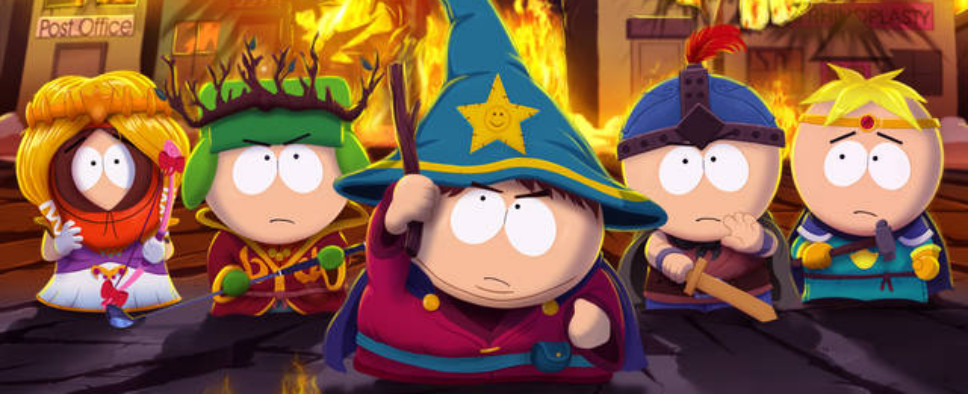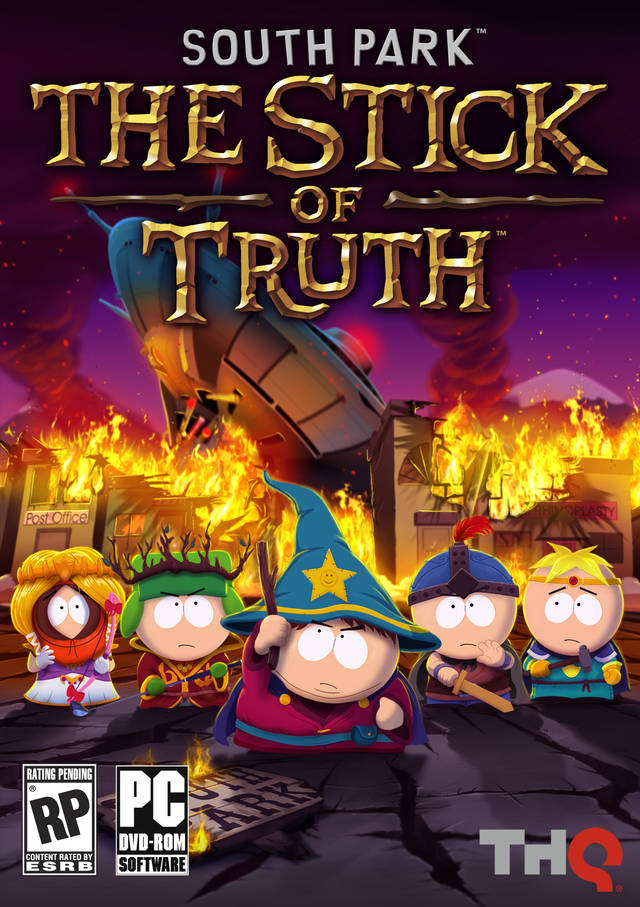South Park: The Stick of Truth Review
-
Category: ReviewsHits: 9867

Article Index
Truth be told, theoretically the combat system has a decent amount of depth, with multiple damage types, status effects, enemy stances that nullify certain types of attacks, shields you have to whittle off to get to an enemy's HP and armor that reduces the amount of damage dealt. And on top of that, Mana can be lost if it's charged above the theoretical maximum (with an, ehrm, peculiar animation and after-effect), summons can be used once per day (less than you'd imagine, given the entire narrative takes the span of only three of them) to help with non-boss encounters, and buddies can be swapped mid-battle at the cost of their turn, should you have the need of a certain type of abilities. But in truth, none of this matters all that much, because pretty much every single class and character has abilities that come in various forms of overpowered. I completed the entire game on Hardcore, the game's highest difficulty level, and I can't say I found even a single fight that was challenging in any way. And that's disappointing, not so much because I was looking for a challenge (although, it has to be said, even if the game is meant to be inviting to South Park fans that aren't into hardcore RPGs, the highest difficulty level is supposed to be more difficult than this), but because the developers have packed an enormous number of jokes in the game's encounters, in the forms of lines of dialogue, special reactions, and absurd, hysterical attacks (my favorite was probably Al Gore's ability to inflict the sleep status by giving a conference on global warming). Most enemies simply don't survive long enough to show off their arsenal unless you purposefully attempt to keep them alive, and that's simply a shame.
Obsidian also missed the opportunity to introduce strategic long-term concerns by making your characters regenerate all their resources except Mana immediately after the encounters end. While I can understand why they did that, as traditionally RPGs tend to be too stingy with resources and don't give enough room to experiment with various abilities, I'd have at least appreciated an optional difficulty mode that disabled the regeneration of at least one of your two main resources. Plus, it would have given me an excuse to use all the healing items I had hoarded, thanks to the game's generous loot drops. The game's low difficulty also affects character progression: there are four classes with unique abilities that get unlocked by raising your level and can be further upgraded to deal more damage and additional effects, class-agnostic perks can be unlocked by spending points you receive by making a large number of friends on Facebook, and a variety of equipment pieces with a number of unique special effects and level requirements attached, which can be further be customized with armor patches, and weapon strap-ons (don't look at me like that, this is a South Park game review). It's possible all of this will be made more meaningful with a balance patch, or even a higher difficulty mode in the future, but a month after release (well, if you don't live in Germany or Austria, anyway), there's still no indication we'll ever get one, and I can only review the game in its current state.
I'm Out of Funny Quotes: Interface, Technical Issues and, Surprisingly, No References to Farts
I find it difficult to call South Park: The Stick of Truth's PC version a good port: it lacks basic functionality like the option to customize your keybinds, the mouse and keyboard controls are obviously second-class citizen when compared to the gamepad (which I ended up using for my playthrough), and, before the latest patch, one minigame mysteriously switched directions from WASD to the arrow keys. And yet, I also can't call it a bad port: it ran flawlessly for me, with a locked 30fps framerate (a choice on Obsidian's part to keep the animations true to the show's style), extremely short loading times and no bugs. I've heard plenty of complaints about technical issues, so I wouldn't go so far as to claim the game is bug-free or, more correctly, as close to bug-free as one could reasonably expect, but I still feel this kind of perspective is worth being offered, as bugs are also fairly subjective, and listening exclusively to those reports would make you believe this game was released in the same state as Knights of the Old Republic II. I can't comment on the state of the console versions, though, according to various reports, the performance tended to suffer, especially on Sony's platform.
The game's approach to usability is also mixed, with a somewhat clunky interface that utilizes a few too many nested menus, a map that's too zoomed-in to be genuinely useful, and slow notifications that sometimes pop up even when you've already checked everything manually yourself. Obsidian's morbid love affair with checkpoint-based save systems (started with Alpha Protocol and continued with Dungeon Siege III) also continues, but in this case, philosophical arguments aside, it's difficult for me to find something to complain in the implementation. The game auto-saves extremely often and also gives you the option to make manual, permanent checkpoint saves, ensuring I never lost any progress at all. Finally, given I'm talking about usability, I should also point out that South Park: The Stick of Truth has the worst tutorials I've ever seen in a game in quite a while. Only a few of them manage to actually explain the kind of inputs you're required to perform remotely accurately, and in at least a few cases (pretty much all the farting tutorials), the actions you're required to do in the tutorial section don't actually match the way the mechanic works in any other situation. I'm not a genius, but I usually understand tutorials and game manuals, so I'm having to conclude that the blame falls solely on the developers' shoulders here.
Finally, given I know plenty of people care about it, I have to mention that the game is pretty short, and ended up clocking 15 hours even after I tried to tackle all the optional side quests. I can understand why it happened, as Parker and Stone are known for being perfectionist with an heavily iterative approach to writing, which doesn't mesh well with typical videogame development pipelines. I personally didn't find it to be a big con, as it also means that the game's pace is consistently fast and that the player is continuously presented new environments and situations, but there are also clear gaps where one could easily imagine cut content, and I wouldn't have objected to a longer game, if Obsidian had managed to keep this kind of quality.
Conclusions
South Park: The Stick of Truth isn't the ultimate South Park video game, weirdly enough. That's not because there are better South Park videogames (Obsidian's title wins easily, as most South Park games are utterly abysmal), but because it isn't what it aims to be. It's a strange pet project from two successful entertainment creators that previously moved from cartoons, to cinema, to Broadway musicals, always finding success along the way. Somewhat expectedly, they also find success here. Perhaps, looking at their history then, it shouldn't be surprising that they did so by writing an actual videogame, and not a South Park story awkwardly inserted into an unnatural format. And really, going back to my initial question, is an RPG even the best format for a South Park story? Well, possibly not. But as it turns out, you can write a South Park RPG that is both clearly South Park and clearly an RPG, and have it be a good game on top of that. That's no small feat. And while I'll be the first to argue that the game is heavily flawed, with far too shallow gameplay and quest design, I still have to tip my hat to everyone involved. I laughed from the beginning to the very end of the game. Yes, even at the fart jokes.


